My agaves and other woody lilies: Alive, dead or in-between? Evaluating plants 2 months after Texas freeze
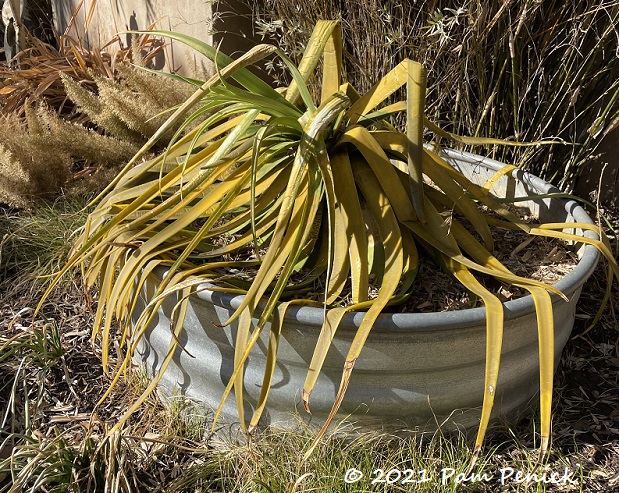
Today I’m taking a look at my woody lilies and bromeliads — plants like agave, yucca, nolina, sotol, hesperaloe, mangave, and dyckia. Some of these plants took a severe hit while others sailed through the freeze. I use them mainly as focal points or as evergreen “shrubs,” and the losses had a big impact, more so because such plants tend to be slow-growing and expensive. Many I grow in containers, to provide sharp drainage or to increase their impact, and unfortunately that made them more vulnerable to extreme low temperatures. Smaller plants in containers that I was able to bring indoors during the freeze are omitted from the list below.
But first, the backstory.
Texas gardeners are feverishly comparing notes about plant survivors and croakers after February’s Big Freeze. I’m doing the same and documenting how every plant in my garden fared. Please see my first post in this series for the introduction and for notes about my trees.
Asterisks indicate plants native to Texas. Plants that were stunted, maimed, or killed by the freeze are in bold, for easier searching.
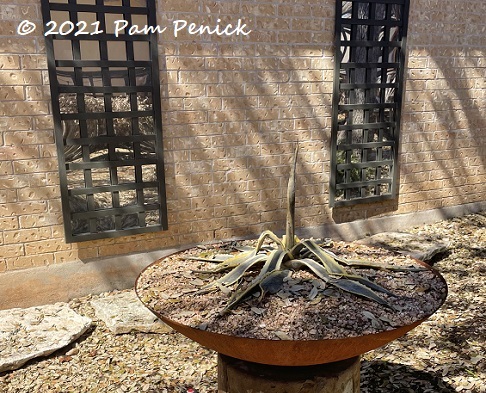
Woody Lilies & Bromeliads
- Agave americana ‘Opal‘ – Variegated American agave ‘Opal’: Killed in an elevated container. I’ve already replaced this one.
- Agave bracteosa – Squid agave: This is a typically very winter-hardy agave, but not at these temperatures. I have 7 in various containers. Three were killed and three others survived with significant damage. One (against the house) survived with virtually no damage. After a couple of weeks I used a serrated bread knife to cut off the mushy or browned leaves, and the survivors should make a full recovery.
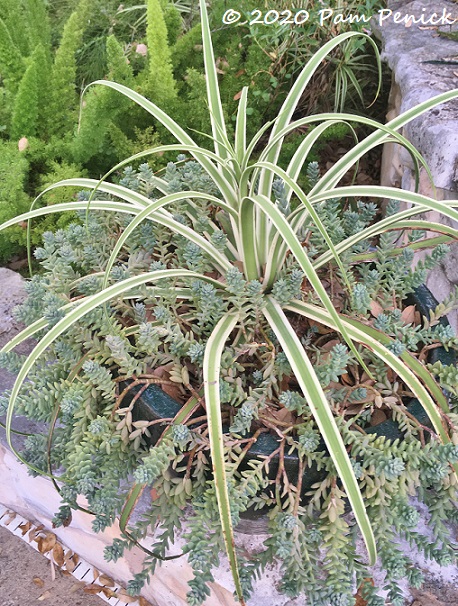
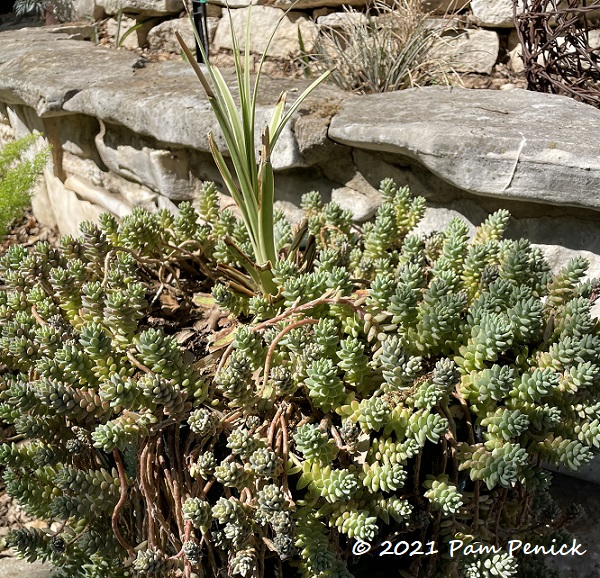
- Agave bracteosa ‘Monterrey Frost’ – Variegated squid agave: A big, beautiful one in a pot was maimed by the freeze (see 2 photos above), but it will survive. I have another smaller one that I was able to bring indoors.
- Agave lophantha*: Significantly damaged in a container. I’ve cut off the mushy leaves, and it will survive.
- Agave lophantha ‘Quadricolor’*: Killed in a container. I’ve replaced it with a pup I’d brought indoors.
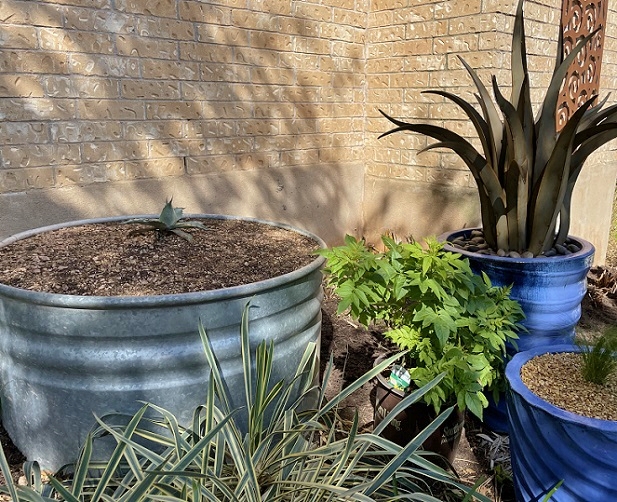
- Agave ovatifolia – Whale’s tongue agave: Aside from ‘Vanzie’ (see below), I have two other good-sized whale’s tongue agaves in containers. One survived with no damage in a tractor-rim planter (with an open bottom). The other one — a variegated whale’s tongue — survived in a pot with a sheet thrown over it, but with damage to its lower leaves, which I cut off. Its moonshine-yellow coloring has also significantly faded, but I’m hoping that will return with hotter weather.
- Agave ovatifolia ‘Vanzie’ – Whale’s tongue agave ‘Vanzie’: Survived in a fire-ring planter (with an open bottom) completely unscathed.
- Agave parryi var. truncata – Artichoke agave: Killed in a container.
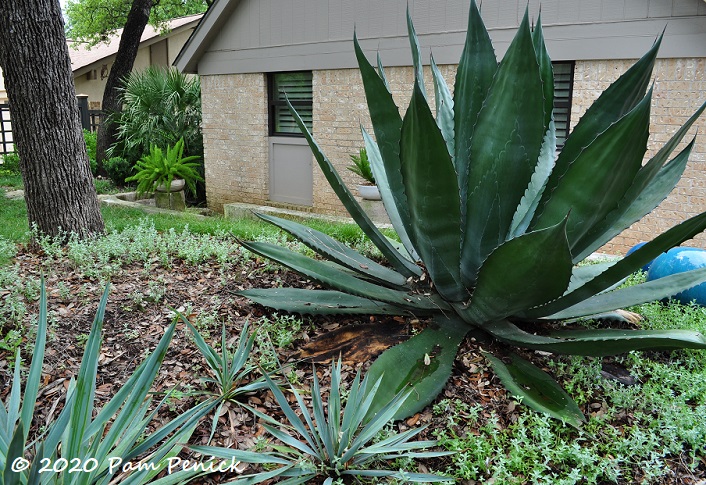
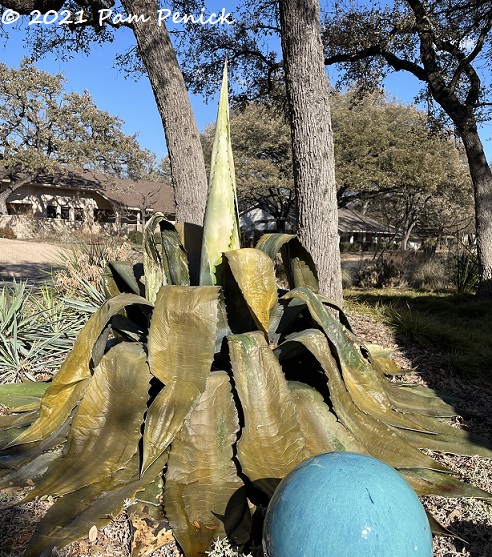
- Agave salmiana var. ferox ‘Green Goblet’ – Green Goblet agave: Killed. I removed it and reluctantly replaced it with a Wheeler sotol, mainly to reduce maintenance. The big ‘Green Goblet’ was a gorgeous agave, but I had to cage it every fall through March to keep male deer from antlering it. It also produced pups, although a manageable number, which I had to pull out to keep it as a solitary specimen. Were it not for the deer, I would have replanted another one.
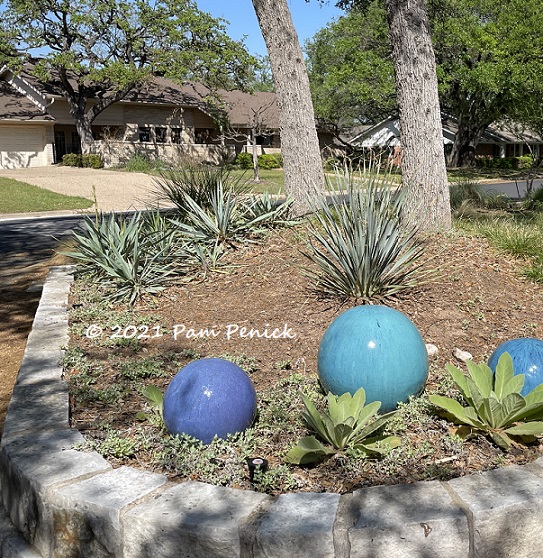
- Dasylirion longissimum – Toothless sotol or Mexican grass tree: Killed. This one makes me sad. I had two, both in elevated planters and typically very winter-hardy. Both seemed to come through the freeze OK, but day by day they turned more and more tan. The big one, which has been growing in a steel pipe for 9 years, still shows a little green in the very center. But I think it’s a goner. Update 5/4: The big one rotted and fell over; it’s dead. The smaller plant died, and I’ve already replaced it.
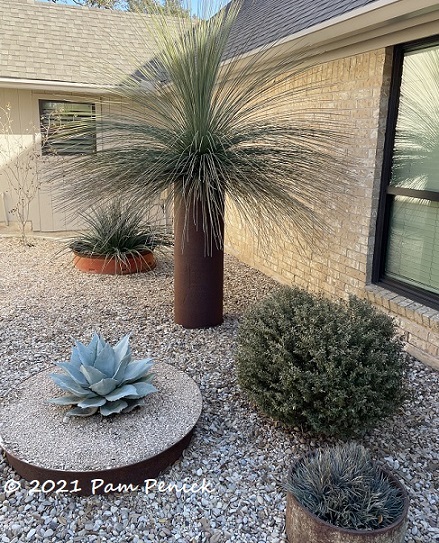
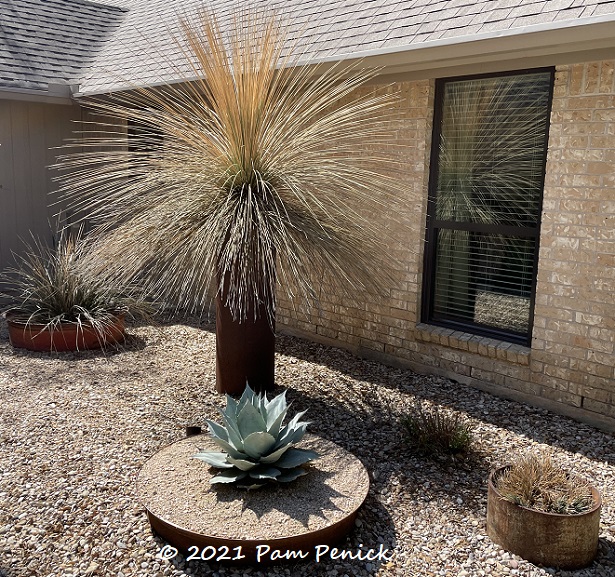
- Dasylirion texana – Texas sotol*: Completely unfazed. One is preparing to flower (see photo below).
- Dyckia ‘Burgundy Ice’: All four plants (in low containers) were killed.
- Dyckia choristaminea ‘Frazzle Dazzle’: Two were killed and two others are barely hanging on. I’ve removed the brown sections from the survivors and am watching to see if they recover.
- Hesperaloe funifera ssp. chiangii – Wide-leaf giant hesperaloe: Completely unfazed.
- Hesperaloe parviflora – Red yucca*: About half the leaves were partially browned, but it already sent up several bloom spikes — which the deer promptly ate.
- Hesperaloe parviflora ‘Desert Dusk’ – Red yucca ‘Desert Dusk’* – I have 3 plants, one in the ground and 2 in containers. The in-ground plant and one container plant suffered no damage. The third one in a container died to the roots but is coming back. I can’t tell why they reacted differently.
- Hesperaloe parviflora ‘Yellow’* – Completely unfazed and now flowering. All three are growing in the ground.
- Manfreda undulata ‘Chocolate Chips’ – ‘Chocolate Chips’ manfreda: One plant in a pot died. Two in the ground were killed to the roots but are quickly rebounding.
- Mangave ‘Macho Mocha’: One plant in a pot died. Several in the ground had pups that survived under the mother plant or were killed to the roots but are coming back.
- Mangave ‘Pineapple Express’: Killed in a pot.
- Nolina nelsonii – Blue nolina: Two plants in the ground, including one I’ve had about 10 years, were killed. San Marcos Growers declares it hardy below 0 degrees, but temps of 5 F killed it in my garden. Perhaps the duration of the freeze together with heavy snow made it less able to tolerate extreme cold. I haven’t decided whether to try again. This is an extremely slow-growing plant that’s pricey at larger sizes.
- Nolina lindheimeri – Lindheimer nolina*: Completely unfazed.
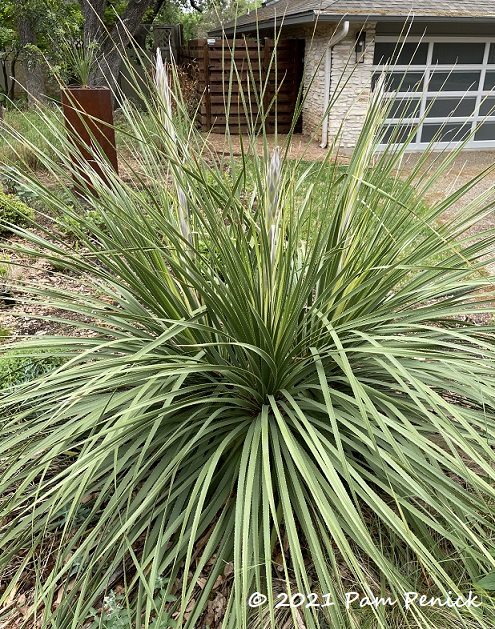
- Nolina texana – Texas nolina*: Completely unfazed, and it flowered soon after the thaw.
- Yucca filamentosa ‘Bright Edge’*: Completely unfazed.
- Yucca filamentosa ‘Color Guard’* – 3 new ones in pots (under a sheet) suffered significant freeze damage, which I cut off. I’m hopeful they will recover. One other in a pot was undamaged.
- Yucca pallida – Paleleaf yucca*: Completely unfazed and sent up flower spikes last week, which the deer ate.
- Yucca recurvifolia ‘Margaritaville’*: Killed to the roots but coming back.
- Yucca recurvifolia – Softleaf yucca*: Minimal damage.
- Yucca rostrata*: Completely unfazed.
- Yucca rostrata ‘Sapphire Skies’*: Completely unfazed.
Up next are Grasses, Sedges, and Bamboos. Click for my earlier posts about:
__________________________
Digging Deeper
Come learn about gardening and design at Garden Spark! I organize in-person talks by inspiring designers, landscape architects, authors, and gardeners a few times a year in Austin. These are limited-attendance events that sell out quickly, so join the Garden Spark email list to be notified in advance; simply click this link and ask to be added. Season 8 kicks off in fall 2024. Stay tuned for more info!
All material © 2025 by Pam Penick for Digging. Unauthorized reproduction prohibited.


In spite of significant damage and loss, there are many bright spots here. I’m amazed and very happy that so many of them not only survived but seem to be unfazed. I think researchers will learn a lot from this once-in-a-century event!
I’ll be curious to know if gardeners and landscapers in Austin continue to use so many agaves, or if they shy away. I hope to see agaves planted to replace those that died. But if people are gun shy it may not happen.
Thank you for this update! I’m in east Austin & am surprised to see so many surviving agaves in my neighborhood sending up floral shoots. I wonder if the stress of the freeze is causing them to flower.
I’m sorry for the succulents you lost, but join in celebration of the many that survived! Thank you for documenting all this–it’s so helpful to compare notes now & to be able to refer to your lists later.
Love that you have sweet Nemo, one of glorious Moby’s pups! May Nemo thrive & flourish!
Yes, I think the stress IS causing many agaves to flower, especially those that melted back to the central growing spear. Thanks for the good wishes for Nemo. I hope he grows fast. That tank is WAY too big for him right now.
Those are the most painful photos yet from my perspective. I’ll be interested to hear about your approach to replanting.
It’s been a race all spring to find replacement plants for those I knew I wanted to replace. But now I’m playing the waiting game with several significant plants (loropetalum, pomegranate, bamboo) to see what happens this summer and to decide what I want to do, if anything, to fill the holes if they die. I’m sure there will be another planting spree this fall.
I love succulents and I have a large dryland bed anchored by these plants. I lost a lot (though, as with you, ‘Vanzie’ was undaunted).
I lost half my A. bracteosa, all my A. parryi, A. victoriae-reginae, A gentryi “Jaws”, A. ‘Green Glow’, A. x “Sharkskin Shoes”, A. striata ‘Live-Wires’, A. protoamericana sp. ‘Hwy 85’ (maybe a pup survived), A. schidigera, half my Drimiopsis maculata, most of my dyckia (Frazzle-Dazzle and one other may make it), Ledebouria socialis (not surprising, but have been happy in the ground for a couple of years), Yucca treculeana, Zamia floridanum
Survivors: Agave x amourifolia ‘Twisted Tongue’, A. lopantha ‘Quadricolor’, Yucca pallida, Y. reverchonii, Y. rupicola, manfreda sileri, Yucca linearifolia ‘Line Dance’ (in a pot), Ledebouria sp. ‘Gary Hammer’, Ledebouria floribunda, Sabal minor, Dasylirion texana, all nolina
Thank god they survived category: Puya dyckiodes (not sure I could replace them now that Yucca-Do is gone), Dioon edule ‘Tamaulipas’, Dioon merolae
All of my frost-sensitive agave and other succulents survived in the house (no power loss, or some of my S. African varieties may have been in danger).
It could have been worse. I do wish Yucca-Do were still around.
You’ve put on a brave face about all those losses, Astra — which is the only thing we can do, I know, but it sure did hurt a month or so ago, didn’t it? Thanks for documenting your survivors and lost plants here too, adding to our collective knowledge about plant hardiness in extreme conditions.
My Cycas panzhihuaensis also survived. The leaves died back but as soon as it warmed up it promptly sent up new growth, increasing about 6 inches a a few days!
That’s great news!
Pam, you may already have this list, but on-line there is “Cold Hardy Landscape Cacti & Succulents for Central Texas”. It’s written by Jeff Pavlat. It lists minimum temps and some notes for certain plants. Of course the Santa Rita lists 0 degrees, but mine didn’t make it in it’s nursery pot and we supposedly only got to 9 degrees, a little warmer than Austin had.
I’ve consulted that list a few times over the years, and I’ll link it here for those who haven’t seen it.
Just want to say that I’m rooting for Nemo! Like parents bravely bringing children into the world to deal with the financial and economic crises we’re leaving for them, plant parents bring their “children” into a world of unknowns.
Go, Nemo, go! 😉
This is so unsettling to read. It seems like about half of your garden plants died. I don’t blame you for being so sad.
Lisa, it can seem that way, reading through these lists. And it’s true that many of my bigger plants — shrubs, small trees, bamboos, agaves, etc. — did suffer damage. But they didn’t all die, and many of those that were hit hard are coming back from the roots. The smaller or dormant plants, particularly those listed already under Perennials, plus my Grasses (coming up soon), were largely unscathed, and they are helping the garden green up quickly this April. So it’s really not all gloom and doom, although inventorying the damage can make it seem so.
I had mixed results, as you did. My large A. salmiana v. ferox (2 in ground, one in large pot) survived with some damage. Their small offsets suffered no damage. My A. ovatifolia, in a large pot, suffered no damage. My Agaves in large pots are planted in a mix that’s mostly drainage rock, so had super fast drainage. I think that helps a lot.
I think you’re right, Peter. So much of the damage with agaves and like plants comes down to whether they can get their feet dry quickly when it’s cold.
It’s so hard to plant for these sort of events and the more unstable weather patterns to come, so these reports on plant damage/survivors will be carefully studied. In my own small garden, I keep boxing myself in with the big toothy agaves and had to remove A. gentryi ‘Jaws’ yesterday. Limitations are such a bore! Best of luck to you with the continued cleanup, rethinking, replanting…
Limitations ARE a bore – ha! But they also help us rise to the challenges of lot size, weather extremes, animal predation, etc. Pros and cons, experimentation, risk and reward. Gardening encompasses all of these things. It’s probably what keeps us interested!